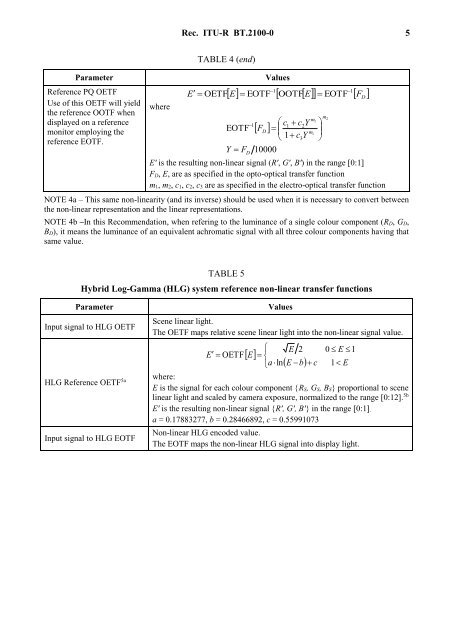range television for use in production and international programme exchange
29jZdmM
29jZdmM
Create successful ePaper yourself
Turn your PDF publications into a flip-book with our unique Google optimized e-Paper software.
Rec. ITU-R BT.2100-0 5<br />
Parameter<br />
Reference PQ OETF<br />
Use of this OETF will yield<br />
the reference OOTF when<br />
displayed on a reference<br />
monitor employ<strong>in</strong>g the<br />
reference EOTF.<br />
where<br />
TABLE 4 (end)<br />
E<br />
OETF<br />
E<br />
EOTF<br />
Y F<br />
EOTF<br />
1<br />
D<br />
Values<br />
1<br />
1<br />
OOTF E<br />
<br />
EOTF <br />
c1<br />
c2Y<br />
FD<br />
<br />
<br />
1<br />
c3Y<br />
10000<br />
E′ is the result<strong>in</strong>g non-l<strong>in</strong>ear signal (R', G', B') <strong>in</strong> the <strong>range</strong> [0:1]<br />
F D, E, are as specified <strong>in</strong> the opto-optical transfer function<br />
m 1, m 2, c 1, c 2, c 3 are as specified <strong>in</strong> the electro-optical transfer function<br />
NOTE 4a – This same non-l<strong>in</strong>earity (<strong>and</strong> its <strong>in</strong>verse) should be <strong>use</strong>d when it is necessary to convert between<br />
the non-l<strong>in</strong>ear representation <strong>and</strong> the l<strong>in</strong>ear representations.<br />
NOTE 4b –In this Recommendation, when refer<strong>in</strong>g to the lum<strong>in</strong>ance of a s<strong>in</strong>gle colour component (R D, G D,<br />
B D), it means the lum<strong>in</strong>ance of an equivalent achromatic signal with all three colour components hav<strong>in</strong>g that<br />
same value.<br />
m1<br />
m1<br />
<br />
<br />
<br />
m2<br />
F D<br />
TABLE 5<br />
Hybrid Log-Gamma (HLG) system reference non-l<strong>in</strong>ear transfer functions<br />
Parameter<br />
Input signal to HLG OETF<br />
HLG Reference OETF 5a<br />
Input signal to HLG EOTF<br />
Values<br />
Scene l<strong>in</strong>ear light.<br />
The OETF maps relative scene l<strong>in</strong>ear light <strong>in</strong>to the non-l<strong>in</strong>ear signal value.<br />
E<br />
OETF<br />
E<br />
E 2<br />
<br />
a<br />
lnE<br />
b<br />
c<br />
0 E 1<br />
1<br />
E<br />
where:<br />
E is the signal <strong>for</strong> each colour component {R S, G S, B S} proportional to scene<br />
l<strong>in</strong>ear light <strong>and</strong> scaled by camera exposure, normalized to the <strong>range</strong> [0:12]. 5b<br />
E′ is the result<strong>in</strong>g non-l<strong>in</strong>ear signal {R', G', B'} <strong>in</strong> the <strong>range</strong> [0:1] .<br />
a = 0.17883277, b = 0.28466892, c = 0.55991073<br />
Non-l<strong>in</strong>ear HLG encoded value.<br />
The EOTF maps the non-l<strong>in</strong>ear HLG signal <strong>in</strong>to display light.


